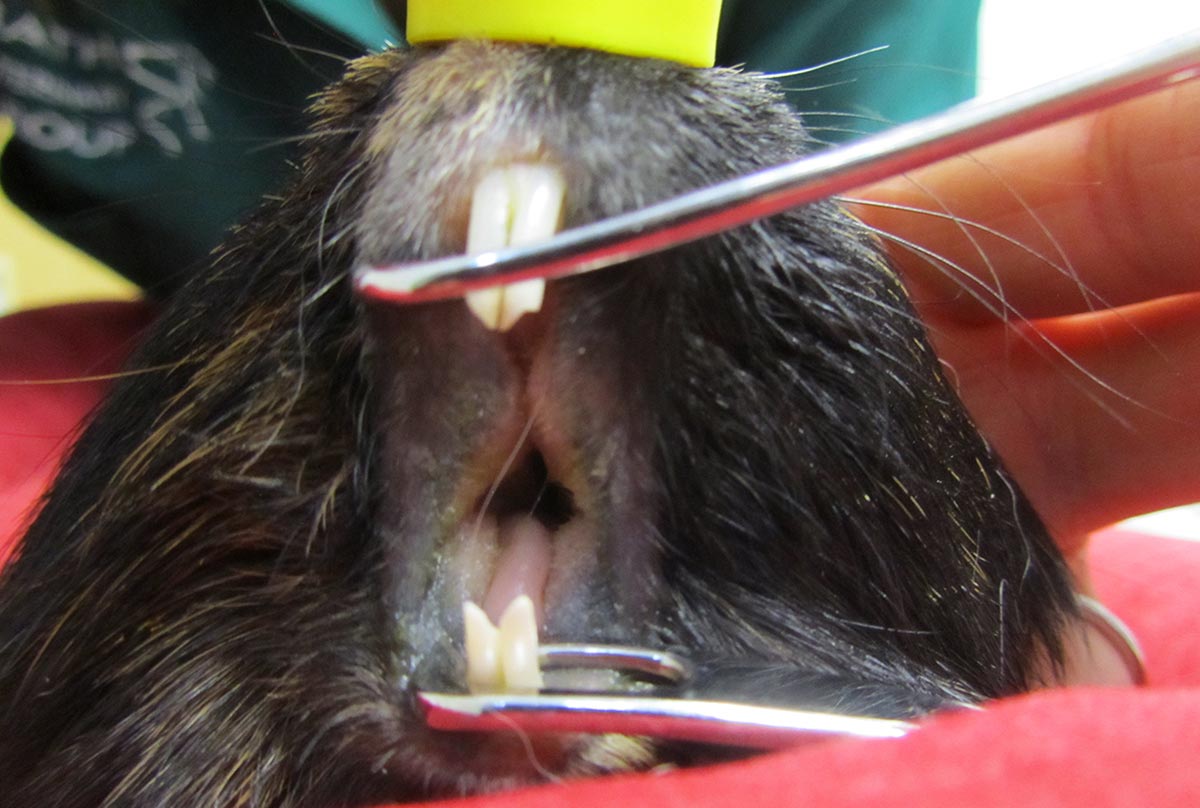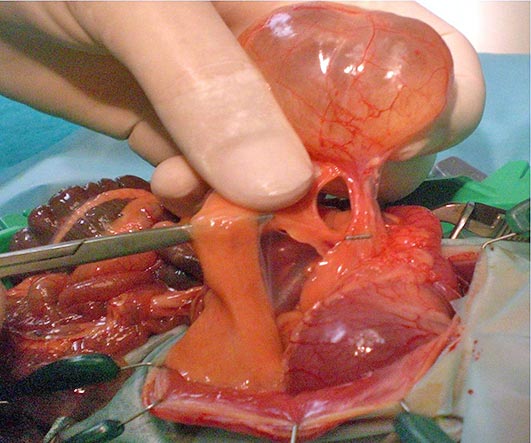4 Apr 2022
Diseases and odontogenic abscesses in guinea pigs
From the <em>Vet Times</em> archives – Elisabetta Mancinelli explores research that has come off the back of increasing awareness of this species.

Figure 1. A guinea pig with advanced dental disease, anaesthetised for oral examination. Dental disease was the most commonly diagnosed in pet guinea pigs.
- This is an extract from “Studies into pet rodent species”, originally published in Vet Times 47.28 (17 July 2017).
Many rodent species, often used as animal models in research, are commonly kept as pets.
The increasing awareness of veterinary professionals towards these species has resulted in an increase in research, which is helping, more often, achieve a definitive diagnosis and establish a more targeted treatment, ultimately improving standards of care.
As practising vets, we should look with interest into these studies, as results may be of clinical interest and applicable in our everyday job.
Diseases in pet guinea pigs
Several publications exist regarding the prevalence of specific diseases or organ pathology in guinea pigs (Gipson and Wagner, 1986; Böhmer and Köstlin, 1988; Fehr and Rappold, 1997; Jekl et al, 2008; Williams and Sullivan, 2010).
In a retrospective study (Minarikova et al, 2015), disease prevalence in 1,000 guinea pigs (544 males and 456 females) kept as pets was described. Animals were divided into three groups based on their age:
- Young (less than two years old). Total number: 561 (296 males and 265 females).
- Middle age (between two and five years old). Total number: 376 (216 males and 160 females).
- Old (more than five years old). Total number: 63 (34 males and 29 females).
Dental disease was the most commonly diagnosed disease (36.3%), with higher prevalence in the middle age group (two to five years old) and in males (P<0.001) rather than females (Figure 1).

Changes most commonly seen included apical and coronal tooth elongation, uneven cheek teeth or incisor occlusal surface, tooth fractures, structural tooth changes or periapical pathology. Periodontitis and presence of hair in the gingival sulci were seen in 10% of guinea pigs with dental disease. Odontogenic abscesses were diagnosed in 3.1% (31 out of 1,000) of cases. Iatrogenic incisor malocclusion, typically caused by veterinary general practitioners using unsuitable tools for incisor clinical crown height correction, was seen in 2.7% (27 out of 1,000) of animals, and was generally characterised by evidence of tooth fracture, uneven occlusal surface, pathological tooth movement, pulpal opening and bleeding.
Müller et al (2015) suggested factors other than diet abrasiveness, such as mineral imbalances and, in particular, hereditary malocclusion, are more likely causes for dental problems observed in this species.
Skin disease was the second most common disorder, with a prevalence of 33.3%, which was higher in male guinea pigs and in animals younger than two years old. Ectoparasites were more commonly seen (Trixacarus caviae, Gliricola porcelli, Chirodiscoides caviae, Gyropus ovalis, Ctenocephalides felis and Ornithonyssus bacoti).
Dermatophytosis was more often described in middle-aged guinea pigs, while skin tumours were more frequently diagnosed in animals younger than two years old. Young guinea pigs have an underdeveloped immune system and a lower concentration of fungistatic fatty acids in their sebum (Vangeel et al, 2000), which could explain the higher prevalence of these disorders.
Reproductive disorders were seen in 15.8% of cases. Ovarian cystic disease was most commonly seen (21.9%), with higher prevalence in females more than two years old (Figure 2). The incidence of tumours affecting the reproductive tract was significantly higher in females than males. Mammary gland tumour prevalence was significantly higher in the older age group and in males.

Other common health disorders included ophthalmological disorders (15%) and gastrointestinal disturbances (13.1%). In particular, “simple” gastric dilatation, and gastric dilatation-volvulus (GDV), were seen in 10 and 34 cases respectively. The prevalence of GDV was significantly higher in guinea pigs more than two years old. Factors predisposing to this condition are still unknown and no direct association with either dietary change or other possible causes of this life-threatening condition was seen during this study.
Respiratory disease was only recorded in 4% of cases in the study, which may be due to the reasonably good husbandry conditions animals were kept in, which reduces risks of pneumonia.
Disorders of the urinary system were diagnosed in 42 guinea pigs; more commonly in females and animals more than two years old. Uroliths mainly contained calcium salts.
Femorotibial OA was the most common musculoskeletal disorder, more often diagnosed in older animals. A lack of, or excess, dietary ascorbic acid may result in osteoarthrosis, suggesting appropriate vitamin C supplementation should be done in this species. Otitis media was diagnosed based on thickening of the tympanic bulla wall in 62 cases. Otitis media in guinea pigs mostly follows a subclinical course, but the clinical impact of this disease is, to date, unknown (Martorell and Vilalta, 2013). Only 8.1% of guinea pigs were healthy; therefore, it is always important to perform a thorough clinical examination and educate clients about the prevention of the most common diseases in guinea pigs.
Odontogenic abscesses
The aforementioned study (Minarikova et al, 2015) confirmed dental disease was the most common condition seen in 36.3% of guinea pig cases.
Odontogenic abscesses, always diagnosed along with dental disease, were seen in 31 out of 1,000 cases and represented a serious health problem to guinea pigs. Clinical manifestation of this condition may include facial masses, respiratory disease and/or exophthalmos (retrobulbar mass) depending on the affected jaw (Minarikova et al, 2015). Treatment may involve a combination of the following:
- extraction of the affected tooth/teeth
- removal of the affected bone
- thorough wound debridement
- supportive care
- analgesia and antibiotic administration
The use of antibiotics should be based on bacterial culture and sensitivity testing (Capello, 2008). However, information about microbial flora of odontogenic abscesses in guinea pigs is limited, making interpretation of bacteriology results challenging.
A prospective study was therefore performed to describe the microbial flora of odontogenic abscesses associated with osteomyelitis in 73 pet guinea pigs (35 females and 38 males, aged from three months old to seven years old) with relative antibiotic sensitivity testing, to be able to make recommendations for practitioners on the antibiotics of first choice (Minarikova et al, 2016). Samples (pus, capsule and affected tooth/bone) for bacteriological examination were collected during the surgical procedure performed to treat the abscess.
The most common isolates were Bacteroides fragilis in 12.8% (6 out of 47) of cases, Pasteurella multocida in 10.6% (5 out of 47) and Peptostreptococcus anaerobius in 8.5% (4 out of 47). Aerobic bacterial species were only isolated in 29.2% (7 out of 24) of cases, anaerobic bacteria was only isolated in 33.3% (8 out of 24), and mixed infection with anaerobic and aerobic bacterial species was seen in 37.5% (9 out of 24).
Similarly, in rabbits, the most common cause of odontogenic abscesses was a mixed infection, particularly with anaerobic Gram-negative rods (predominantly Fusobacterium nucleatum), anaerobic Gram-positive, non-sporulating rods (predominantly Actinomyces species) and aerobic Gram-positive cocci (especially the genus Streptococcus milleri; Tyrrell et al, 2002). In guinea pigs, aerobes (n = 20) were sensitive to enrofloxacin and marbofloxacin in 100% of samples, benzylpenicillin potassium (penicillin G; PNCG) in 90%, cefalotin in 85%, amoxicillin/clavulanate in 75%, doxycycline in 70%, gentamicin in 65% and trimethoprim-sulfamethoxazole in 55%. Anaerobes (n = 27) were sensitive to amoxicillin-clavulanate in 100% of cases, clindamycin in 96.3%, metronidazole in 92.6%, PNCG in 92.6% and cefalotin in 74.1%.
As guinea pigs are strictly herbivorous animals in which penicillins and clindamycin can potentially cause clostridial infections and toxaemia, based on the results of this study the recommended antibiotic treatment for odontogenic abscesses is a combination of fluoroquinolones (enrofloxacin and marbofloxacin) with nitroimidazole antibiotics (metronidazole), while waiting for sensitivity results.
Authors have also pointed out Pseudomonas aeruginosa is a potential nosocomial pathogen (Lister et al, 2009). As some of the other bacteria (Bacteroides species, Prevotella oris and Fusobacterium species) isolated in the study may have zoonotic potential and cause respiratory, skin, brain or mouth cavity infections, it is necessary to use personal protective equipment during surgery. Thorough disinfection of the hospital environment where the sick guinea pigs are kept (cage/box) is also advised and clients should be informed about any possible zoonotic potential of isolated bacteria from odontogenic abscesses in this species.
References
- Böhmer E and Köstlin R (1988). Zahnerkrankungen bzw. -anomalien bei Hasenartigen und Nagern, Der praktische Tierarzt 69: 37-50.
- Capello V (2008). Clinical technique: Treatment of periapical infections in pet rabbits and rodents, J Exot Pet Med 17(2): 124-131.
- Fehr M and Rappold S (1997). Urolithiasis in 20 guinea pigs (Cavia porcellus), Tieraerzliche Praxis 25: 543-547.
- Gipson SW and Wagner JE (1986). Cryptosporidiosis in guinea pigs: a retrospective study, J Am Vet Med Assoc 189(9): 1,033-1,034.
- Jekl V, Hauptman K and Knotek Z (2008). Quantitative and qualitative assessments of intraoral lesions in 180 small herbivorous mammals, Vet Rec 162(14): 442-449.
- Lister PD, Wolter DJ and Hanson ND (2009). Antibacterial-resistant Pseudomonas aeruginosa: clinical impact and complex regulation of chromosomally encoded resistance mechanisms, Clin Microbiol Rev 22(4): 582-610.
- Martorell J and Vilalta L (2013). Subclinical middle ear disease in guinea pigs, Proceedings of the 1st International Conference on Avian, Herpetological and Exotic Mammal Medicine, Wiesbaden, Germany: 115.
- Minarikova A, Hauptman K, Jeklova E et al (2015). Diseases in pet guinea pigs: a retrospective study in 1,000 animals, Vet Rec 177: 200.
- Minarikova A, Hauptman K, Knotek Z et al (2016). Microbial flora of odontogenic abscesses in pet guinea pigs, Vet Rec 179(13): 331.
- Müller J, Clauss M, Codron D et al (2015). Tooth length and incisal wear and growth in guinea pigs (Cavia porcellus) fed diets of different abrasiveness, J Anim Physiol Anim Nutr (Berl) 99(3): 591-604.
- Tyrrell KL, Citron DM, Jenkins JR et al (2002). Periodontal bacteria in rabbit mandibular and maxillary abscesses, Journal Clin Microbiol 40(3): 1,044-1,047.
- Vangeel L, Pasmans F, Vanrobaeys M et al (2000). Prevalence of dermatophytes in asymptomatic guinea pigs and rabbits, Vet Rec 146(15): 440-441.
- Williams D and Sullivan A (2010). Ocular disease in the guinea pig (Cavia porcellus): a survey of 1,000 animals, Vet Ophthalmol 13: 54-62.
